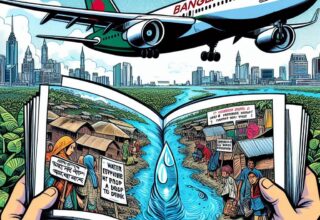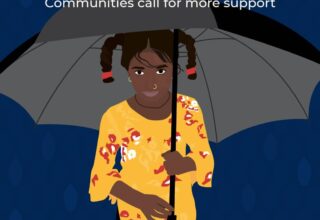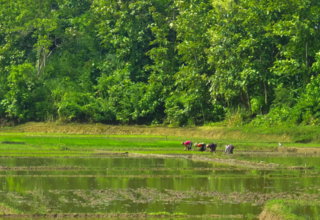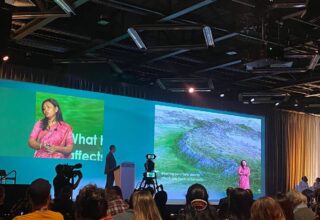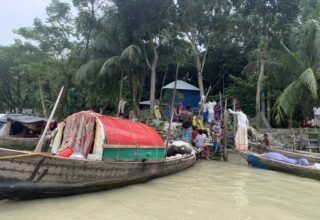(Original blog can be found here)
Introduction
ADAMs, (Association Development Activity Manifold Social Work) is a Non- Governmental Organization working in 10 districts across southern Bangladesh. Founded in 1994, ADAMs now has over 63,000 beneficiaries, the vast majority of which are women. However ADAMs also targets the rural poor, marginalised communities, slum dwellers, environmentally stressed, and ethnic communities through a variety of projects.
ICCCAD has partnered ADAMs to help capacitate and provide knowledge to their staff on climate adaptation and livelihood interventions. Within this partnership, ICCCAD can be thought of as the ‘thinking’ body whilst ADAMs is the ‘doing’ action- orientated catalyst.
ADAMs were good enough to invite ICCCAD Visiting Researchers Liz DaBramo, Muzna Rahman, Kasia Wieszczeczynska and Liam Upson to see their work in Mollahat, Khulna district as well as their work in slums in Khulna city.
ADAMS’ Integrated Training Center in Mollahat
The Centre in Mollahat is a lovely place located in picturesque area. Among rich and dense vegetation, there are a few scattered buildings and a water feature that encourages discovering, wondering and provides a peaceful place for learning and skills development. We were impressed by the success of the centre, focusing on capacity building of women, trade skills for men, education of children and self-sustained income generating. The principal of the centre proudly gave us a tour around the campus facilities: computer, tailoring, electronic, automobile, and pre-preliminary school, each with organized benches, proper tools, and chalkboards instructions.
We had an opportunity to see the class of 3-6-year-old children using educational materials developed by ADAMS to equip them with basic Bangla language, English language and mathematics skills. Two classes are held daily, one in the morning and one in the afternoon. Sadly, the funds for the educational programme from the German donors (Die Lichtbrücke e. V. Germany) were withdrawn. However, thanks to self-sustaining activities such as chicken and fish breeding, the centre has sustained 20 of the 48 existing schools in the area.
In regards to the trade school, low-income people attend from various regions of Bangladesh. Sewing workshops consist of two classrooms and a block printing shop with a variety of fashionable prints. We were introduced to a few Bangla words for pajama measurement: wrist, hips and chest. We were surprised that the electronic and automobile workshops were empty, but the principal informed us most of the willing men in the surrounding villages were already trained. On the other hand, the computer class was full of focused students learning Microsoft Excel.
The skills acquired at the trade school of ADAMS allows for income generation for rural poor. Graduate students have opportunity for taking microcredit loans for initial investment in their business. From ADAMs alumni tracking data, we could see that many people were employed in various regions of Bangladesh as well as South Arabia and the United Arab Emirates and their monthly wages varied from approximately 1,000 – 45,000 BDT.
Integrated Development for Rural Women (IDRW)
ADAMS works extensively on empowering poor-income rural and urban women by enhancing skills and livelihood capacity. ADAMS has two major educational centres set up to enable women to come in and learn income-generating skills. Activities include sewing using machines, tie-dying, block printing and limited nursing skills. Women were offered these skills free of charge with the end-goal of independent income-generation in mind. The sewing is particularly popular as it capacitates women to work at home.
These women have a varying levels of literacy and education, and often already have a full roster of domestic duties to fulfil. Furnishing them with skills that can translate to immediate income generation, that can be done within the convenience of their own homes, is appealing to them. ADAMS director Ali Aslam explained that it was of the utmost importance that the women were able to produce an income that was separate from their husband’s control, to enable them to exercise full authority of how, when and why the money is spent. This type of skills training has a direct effect upon the woman’s place in the home and consequently society at large. This strikes to the very heart of women’s liberation in the Bangladeshi context.
We were fortunate enough to be able to visit one of the school’s successful graduates in her own home, where she had set up a one-woman business as a seamstress. We entered the small room she had established for the sole purpose of her sewing trade, and showed us her sewing machine which she had recently upgraded from an older non-electrical machine, with the profits from her thriving trade. The woman showed us the made-to-fit three piece salwar khameez she offered to customers at 500 taka a dress, with 100 taka going into her pocket for the sewing services. She explained she made about 50 profit taka on each dress, taking into account the cost of the bulk purchase of three-piece unmade dresses. She said on average she made 5-6 dresses a day.
She was pleased to tell us that her business had thrived because she was skilled and people would come from farther than her immediate village for her clothes, because they appreciated her technique. She was realistic about the added work the business produced for her, having a husband and children at home to look after as well, but soldiered on because of the benefits of the financial independence. It was edifying to witness grass-roots development in practice.
Solar Home System (SHS)
ADAMs manages and coordinates the SHS project, which is committed to installing and servicing solar PV cells in communities within Khulna district; to provide families and communities access to electricity. The SHS project began three years ago, when small solar PV cells were installed within slums in Khulna city. Owing to the success of the project, installation and servicing of solar PV has now been upscaled to a rural community in Mollahat.
Solar PV cells have a working life of around 20 years, and are regularly serviced by ADAMs field coordinators. After a small solar PV cell of either 30 or 40 watts is installed in a community, they then pay a monthly tariff for three years, until the cost of the PV cell is paid off fully.
We were fortunate to have been invited to visit one home, who only had access to electricity for one week, having had a small 40 watt solar PV panel installed on their roof. The PV cell, although small, was able to power a lightbulb, radio and TV-set.
The impact of this directly and indirectly is far-reaching and extensive. For instance, with light in the home, children are able to stay up beyond daylight hours to do their schoolwork and reading, consequently improving how they perform at school. Additionally, having access to electricity gives women the opportunity to be entrepreneurs and start a business for themselves, thus empowering them to be independent and less reliant on their husbands. The community we met now have aspirations to purchase a fridge.
Climate Change Adaptation Program (CCAP)
Visiting the Climate Change Adaptation Project (CCAP), a part of the larger Comprehensive Climate Change Management Program (CCCMP), was personally the most eye-opening experience of the entire trip. In the past ten to fifteen years, the low-lying coastal region has been significantly affected by flooding, saline intrusion, sea level rise, riverbank erosion and erratic rainfall – among other climate change impacts.
In response to the environment stressors, ADAMs reclaimed a large land area, erected river embankments, installed flood resistant latrines, raised several community houses and chicken coops, and introduced adaptive fisheries.
We arrived on boat to a small village to be greeted by a group of women gathered for collection of their micro-loans. With help from our patient translator Muzna, we learned from the women that ADAMs reclaimed three feet of the ground we were sitting on and planted vegetation along the bank to prevent erosion. Our guide pointed out a chicken coop, tube well, and latrine that was recently elevated to resist flooding.
Our guide pointed out the river embankment, a hefty barrier of mud and sand, which formed a small pond between the river and the village as a buffer during high tide. Even with large financial investment and engineering expertise, the river eroded the barrier forming a leak that seeped water into the village, leaving standing water and a higher risk for vector-borne diseases. However, repair and expansion of the embankment requires a further and substantial investment.
We walked further and higher to the flood shelter, an area raised eight feet by ADAMs, which contained another flood-resistant latrine, tube well, a small Hindu temple, and space for residents to temporarily live. During exceptionally high flooding, residents erect temporary shelters and have refuge for a few weeks before the water recedes.
In addition to establishing a flood shelter area, ADAMs raised every home in an adjacent community. With the help of the community members, the homes made of tin and dried leaves are raised and the new foundation is set in under two hours. The only house that has yet to be raised is brick and concrete. We visited this home to discover that it is inundated with water every single day! To combat this problem, ADAMs has provided a pump until they can raise the concrete floor.
Conclusion
ADAMs has an effective, multi-faceted approach to addressing the various needs of the community. Partnerships, such as with ICCCAD, have promoted further action-based research including climate change mitigation and adaptation. Strengthening their own income generation, ADAMs can transition from relying on foreign aid to self sufficiency.
The visiting researchers at ICCCAD would like to thank ADAMs for their generous, informative, and eye-opening introduction to their work in Mollahat and Khulna.

